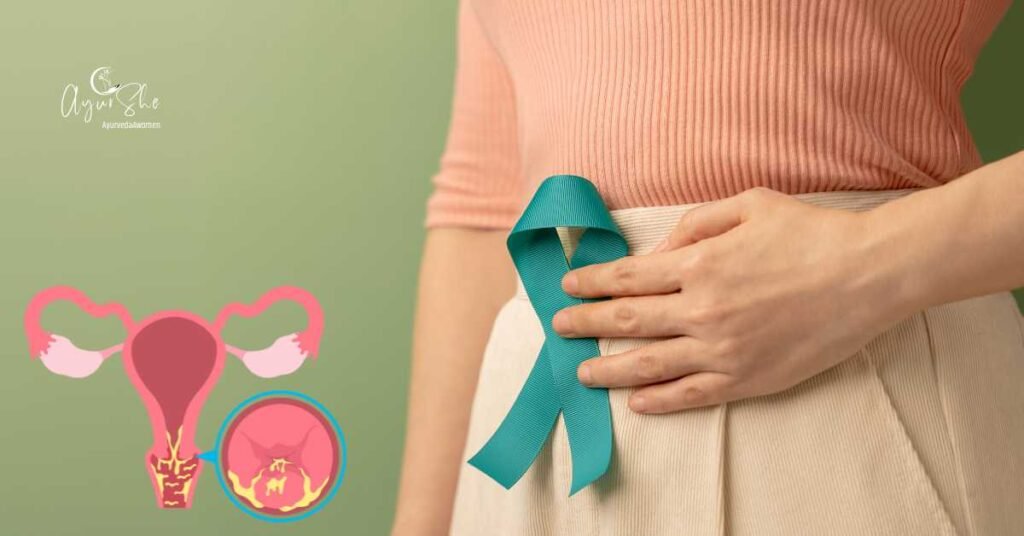Ovarian cancer is often called the “silent” gynecologic cancer because early symptoms are vague—bloating, pelvic pressure, early satiety—and are easily mistaken for digestive issues. That “silence” leads to late diagnoses and poorer outcomes than many other cancers. Yet there’s good news: awareness of risk factors, screening indications for high-risk women, and early symptom patterns can prompt earlier evaluation. Alongside modern oncology, Ayurveda contributes a terrain-focused approach—cooling pathological inflammation, improving digestive-metabolic balance (Agni), clearing toxic residue (Āma), supporting immunity (Ojas), and improving quality of life during and after treatment.
This article gives an authentic, practical integration of modern science with classical Ayurvedic logic, including precise herb/formulation dosages and how to use them—aimed at prevention, treatment support, and survivorship care.
Part I — Ovarian Cancer: Modern Overview
What is it?
A malignant growth arising from the ovary or fallopian tube. The commonest type is epithelial ovarian carcinoma. Others include germ-cell and sex-cord stromal tumors (more common in younger women).
Who is at higher risk?
- Age: risk rises after 45; peak in post-menopausal years.
- Family history/Genetics: BRCA1/BRCA2 or Lynch syndrome significantly increase risk.
- Reproductive factors: nulliparity, endometriosis, late menopause.
- Lifestyle/medical: obesity, hormone therapy (nuanced), talc exposure (debated).
Protective factors (population associations)
- OCP use ≥5 years, multiparity, breastfeeding, and tubal ligation show lower lifetime risk (epidemiologic observations).
“Silent” but not silent—key early clues
- New-onset or progressive bloating, pelvic/abdominal pain, early satiety, urinary frequency/urgency, change in bowel habits, unexplained fatigue persisting >2–3 weeks.
Diagnosis & staging
- Pelvic exam → Transvaginal ultrasound (TVUS) for adnexal mass, Doppler indices.
- CA-125, HE4, and multivariate scores aid risk assessment (not stand-alone screening in average risk).
- CT/MRI/PET-CT for extent.
- Surgical staging/debulking (laparotomy/laparoscopy) confirms histology and stage.
Modern treatment pillars
- Primary cytoreductive surgery (maximal safe debulking).
- Platinum-taxane chemotherapy (e.g., carboplatin + paclitaxel).
- Maintenance therapy in select cases: PARP inhibitors (esp. BRCA/HRD+), bevacizumab.
- Recurrence management: re-challenge with platinum, targeted agents, trials, palliative care.
Survivorship & adverse effects to anticipate
- Fatigue, nausea, peripheral neuropathy, constipation/diarrhea, myelosuppression, hair loss, sleep & mood issues, surgical menopause symptoms, ascites/bloating in advanced disease.
Part II — Ayurvedic View: Mapping the Terrain
Classical correlations
While “ovarian cancer” isn’t named, features map to:
- Arbuda (malignant tumor): hard/immobile growths due to Tridoṣa derangement, Rakta and Māṃsa tissue pathology, Srotas obstruction.
- Granthi (nodular swellings): Kapha-dominant masses which, with chronic Pitta-Rakta vitiation and Vāta disturbance, can turn aggressive.
- Artavavaha Srotas duṣṭi: deranged reproductive channels.
Samprāpti (pathogenesis) logic
- Mandāgni → Āma formation (metabolic waste).
- Āma + Pitta-Rakta duṣṭi → chronic inflammation, cellular dysregulation.
- Kapha vr̥ddhi → mass effect, stickiness, stromal support to tumor.
- Vāta prakopa → spread, pain, cachexia.
- Ojas kṣaya under chronic stress, treatment toxicity.
Ayurvedic goals
- Doṣa śamana (especially Kapha-Pitta control; Vāta containment).
- Āma-pācana & Srotoshodhana (improve metabolic clearance, reduce sludge).
- Rasāyana (immune-neuroendocrine resilience).
- Śotha-hara & Vedanā-sthāpana (anti-inflammatory, analgesic).
- Manas-prasādana (calm mind; improve sleep and adherence).
Positioning: Ayurveda is adjunctive, not a substitute for surgery/chemo/targeted therapy. Use collaboratively with the oncology team.
Part III — Integrative Plan by Phase (with Dosage & How-to-Use)
Adult doses. Adjust for age, weight, renal/hepatic status. In pregnancy/post-op bleeding risk, or with anticoagulants, use only under direct supervision. Space all herbs 2–3 hours away from chemo medicines on infusion days.
A) Pre-treatment / Pre-surgery (2–4 weeks if time allows)
Purpose: optimize Agni, bowel regularity, micronutrition, calm inflammation.
- Āma-pācana & Agni support
- Trikatu churna (dry ginger + black pepper + long pepper): 1/4–1/2 tsp with warm water BID before meals for 10–14 days (avoid if reflux/ulcer → use milder Hingvastaka 1/2 tsp with ghee in food).
- Triphala churna: 1 tsp in warm water at bedtime (bowel tone, antioxidant).
- Pitta-Kapha moderation & Rakta support
- Mahāmanjishthādi kwath: 20–30 ml, BID before meals (Rakta-prasadana, anti-inflammatory).
- Guduchi (Tinospora cordifolia): 500 mg capsule, BID after food (immunomodulatory).
- Rasāyana base
- Amalaki: 500 mg, BID or 15–20 ml fresh juice AM (antioxidant, collagen support).
- Ashwagandha: 3–5 g churna in warm milk/ghee HS (sleep, strength).
B) Peri-operative (around surgery)
- Stop blood-thinning herbs (guggulu, high-dose turmeric, garlic) 7–10 days pre-op.
- Use clear liquids, ginger-coriander tea small sips for nausea day-of (unless NPO).
- Post-op, once cleared for oral intake:
- Yashtimadhu phanta (licorice tea): 150–200 ml warm, BID (soothes mucosa; avoid if hypertensive/edematous).
- Shallaki (Boswellia) 300–500 mg BID for analgesic-anti-inflammatory support if NSAID-sparing is desired (confirm with surgeon).
C) Chemotherapy/Targeted-Therapy Phase
Goals: reduce fatigue, GI upset, neuropathy risk; maintain counts and appetite; support sleep/mood.
- Nausea & appetite
- Shunthi (dry ginger) 250–500 mg cap TID with warm water on infusion day and 48–72 h after (compatible with standard anti-emetics).
- Jeera-Dhānya-Saunf water (cumin-coriander-fennel): boil 1 tsp each in 1 L water, sip through the day.
- Mucositis / mouth sores
- Triphala-turmeric warm rinse: 1/4 tsp Triphala + a pinch of turmeric in a cup of warm water; swish 3–4×/day, do not swallow if nauseous.
- Gandusha (oil pooling) with coconut/sesame oil 5–7 min daily if tolerated.
- Peripheral neuropathy
- B-complex (modern) + Ashwagandha 500 mg BID + Bala-Taila abhyanga (oil massage) to calves/feet 10 min nightly, then warm water wipe.
- Mahanarayana Taila local application 5–10 min where tingling/burning is felt.
- Fatigue, mood, sleep
- Ashwagandha (if not already): switch to caps 500 mg BID daytime if milk intolerant.
- Brahmi (Bacopa) 250–500 mg BID (daytime cognition/mood).
- Jatamansi churna 500–750 mg HS (sleep depth; avoid in low BP).
- Hematologic support (general wellness)
- Amalaki 500 mg BID + Guduchi 500 mg BID throughout cycles unless physician advises pause.
Important: Avoid starting high-dose turmeric/curcumin on the exact infusion day if your oncologist prefers—evidence is mixed for certain regimens. Resume low-to-moderate culinary doses on non-infusion days unless told otherwise.
D) Maintenance / Remission Phase (first 12 months)
Aims: reduce relapse drivers (inflammation, insulin resistance), optimize hormones, restore Ojas.
- Kanchanār Guggulu 500 mg, BID after meals for 12 weeks, then reassess (lymphatic decongestion, residual mass milieu). Avoid if on anticoagulants without supervision.
- Mahāmanjishthādi kwath 20–30 ml BID before meals + Guduchi 500 mg BID (8–12 weeks cycles).
- Chyawanprash 1 tsp AM (on non-diabetic, non-mucositic mouth) or Brahma Rasāyana 1 tsp AM for cognition/energy.
- Triphala HS continues for gut-microbiome regularity.
E) Advanced disease / Ascites-dominant palliation (supportive)
- Punarnavāsava 15–20 ml with equal water BID after meals (edema/ascites support; monitor BP/renal status).
- Varunādi kwath 20 ml BID for diuretic-anti-inflammatory synergy.
- Light Pitta-Kapha pacifying diet (see below), small frequent meals, supervised paracentesis as needed (modern).
Part IV — Diet (Āhāra), Lifestyle (Vihāra), and Daily Rituals
Cancer-smart plate (Ayurveda × nutrition science)
- Favor (Sāttvika, anti-inflammatory):
- Warm mung-dal khichdi with ghee (1–2 tsp/day), seasonal cooked veggies (bottle gourd, ash gourd, pumpkin, ridge gourd).
- Whole grains: old rice, barley, millet (if digestible).
- Protein variety: mung, masoor, sprouted legumes; paneer/curd at lunch if tolerated.
- Spices: turmeric (culinary), coriander, cumin, fennel, black pepper (mild).
- Fruits: pomegranate, amla, pear, apple (stewed in mucositis).
- Limit/Avoid: deep-fried, ultra-processed, heavy red meat, refined sugar; very spicy/sour; alcohol; reheated oils.
Hydration
- Warm water or coriander-fennel infusion; aim 30–35 ml/kg/day unless restricted.
Daily nervous-system reset
- Abhyanga (sesame or Bala taila) 10–15 min, then warm shower—3–5×/week (skip on chemo day if sensitive).
- Prāṇāyāma: Nādi Śodhana 7–10 min, Bhrāmarī 3–5 min (AM/PM).
- Yoga: gentle flows—Supta Baddha Koṇāsana, Viparita Karani, Shavāsana; avoid strain post-op.
- Sleep: 7–8 h; Jatamansi or warm nutmeg-milk (a pinch of jāyaphal + 1 tsp ghee) HS if insomnia.
Part V — A 12-Week Adjunct Protocol (Template)
Use alongside oncology plan. Modify per labs, appetite, bowel pattern.
Weeks 1–4 (Reset & Digest)
- Triphala 1 tsp HS; Mahāmanjishthādi kwath 20–30 ml BID pre-meals; Guduchi 500 mg BID; Ashwagandha 500 mg BID (or 3 g HS with milk); Amalaki 500 mg BID.
- Diet: warm, light, Pitta-Kapha pacifying; coriander-fennel water.
Weeks 5–8 (Build & Balance)
- Continue above; add Brahmi 250–500 mg BID (focus/sleep architecture).
- If edema/ascites: Punarnavāsava 15–20 ml BID (after meals).
Weeks 9–12 (Consolidate & Taper)
- Continue Guduchi, Amalaki; consider Kanchanār Guggulu 500 mg BID for 12 weeks (if no contraindication).
- Maintain Triphala HS, pranayama, abhyanga.
Then cycle: 2 weeks off herbs (except Triphala), reassess energy, bowels, labs; re-enter a lighter maintenance stack.
Part VI — Safety, Interactions, and “Do-Not-DIY” Zones
- Not a replacement for surgery/chemo/targeted therapy.
- Bleeding risk: Pause guggulu/curcumin/garlic around surgery or if platelets very low.
- Hepatic/renal caution: Dose-adjust many herbs; avoid asavas if severe hepatic issues.
- Hypertension/edema: Use licorice (Yashtimadhu) only short-term and monitor BP.
- Drug interactions: Keep 2–3 h gap between herbs and chemo/targeted agents on treatment days; coordinate with the oncologist.
- Fever, uncontrolled vomiting, bowel obstruction, acute thrombosis, rapid ascites → urgent hospital care.
Part VII — FAQs (SEO Boosters)
Q1. Is there any screening test for average-risk women?
No single reliable population screening exists. High-risk women (BRCA/Lynch, strong family history) should seek genetic counseling, periodic TVUS/CA-125 as advised, and discuss risk-reducing options with gynecologic oncologists.
Q2. Can Ayurveda shrink ovarian tumors?
For confirmed cancer, tumor control relies on surgery/chemo/targeted therapy. Ayurveda’s proven role is symptom control, terrain optimization, and recovery support; do not delay oncologic treatment.
Q3. What helps chemotherapy-induced neuropathy?
Ashwagandha 500 mg BID, Bala/Mahanarayana taila abhyanga, B-complex, gentle calf stretches, and sleep optimization. Coordinate with your team.
Q4. How long should integrative support continue after remission?
Typically 6–12 months of a light Rasāyana + Āma-pācana stack with seasonal breaks, plus lifelong diet/lifestyle hygiene.
Conclusion
Ovarian cancer is best tackled through earlier suspicion, swift modern treatment, and terrain-strengthening Ayurvedic care. While surgery and systemic therapy target the tumor, Ayurveda enhances digestion, detox, immunity, inflammation control, resilience, and quality of life—all decisive for recovery and recurrence risk.
A disciplined combination of Mahāmanjishthādi + Guduchi + Amalaki + Ashwagandha, gut-friendly diet, prāṇāyāma, abhyanga, and carefully timed add-ons like Kanchanār Guggulu can make the journey safer, steadier, and more livable—without compromising oncologic precision. With both sciences working together, women gain not just added years but better years.




